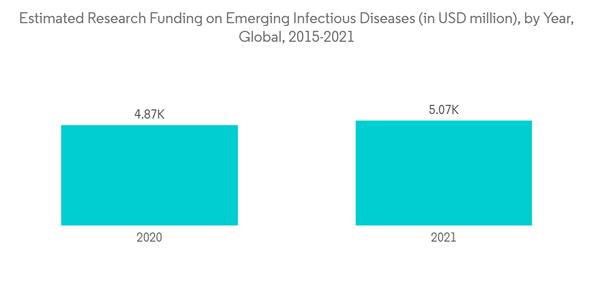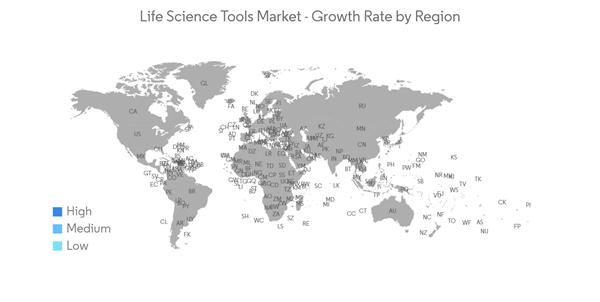The life science tools market is expected to record a CAGR of 7.5% during the forecast period.
Globally, the COVID-19 pandemic positively impacted the growth of the life science tools market with the rapid development of diagnostics, fast-tracked regulatory clearances, and increased distribution in various countries to help curb the spread of the virus. Various diagnostic procedures have always been essential in the detection of infectious diseases. Currently, several molecular assays and immunoassays are in place to detect COVID-19. However, in the aftermath of the pandemic, there has been increased research in the life sciences industry to prepare for any unexpected global pandemic burden. For instance, in September 2022, the WHO issued a guidance framework for the responsible use of life science tools. The Framework calls on leaders and other stakeholders to mitigate risks and safely govern dual-use research, which has a clear benefit but can be misused to harm humans, other animals, agriculture, and the environment. Hence, with the increasing focus on life science, the market studied is expected to grow significantly in the coming years.
Genomic technologies are increasingly being used globally to understand and contribute to developing new diagnostic tests or procedures for various diseases, boosting the market’s growth. For instance, in September 2022, Becton, Dickinson, and Company (BD) and CerTest Biotec commercially launched their new molecular polymerase chain reaction (PCR) assay for the monkeypox virus for the US and global markets. The company has stated that this PCR assay will only be available for research purposes. With such new launches, the market is expected to witness strong growth over the forecast period.
Furthermore, technological advancements associated with sequencing technologies, chromatography methods, mass spectrometry, and other products led to the increasing adoption of these tools in hospitals, research labs, and diagnostic laboratories. According to the WHO 2021 Factsheet, 680,000 people died from HIV-related causes, and 1.5 million people acquired HIV. Thus, a high patient population will boost the demand for treatment and further increase the use of life sciences tools for identifying, diagnosing, and monitoring the progression of several infectious diseases.
Furthermore, the rising demand for diagnostic tests for a variety of infectious diseases will spur the development of life science tools for diagnosing the target population, propelling overall market growth over the forecast period.
Globally, the COVID-19 pandemic positively impacted the life science instruments market. The outbreak of COVID-19 resulted in an increased number of diseases, which led to a subsequent increase in research and development activities. Increasing investment in drug discovery is expected to fuel the growth of the separation technology segment. For example, in May 2022, Cipla announced the commercialization of its COVID-19 PCR kit in India. The real-time RT-PCR test kit has been validated by an Indian Council of Medical Research (ICMR)-approved center.
Separation technologies include immunoprecipitation, chromatographic techniques, automated purification systems, and others that aid in diagnosing and treating COVID-19. For example, according to the Indian Journal of Medical Research 2021, a study was conducted in a tertiary care teaching hospital in northern India to assess a rapid immunoassay-based chromatographic test in the diagnosis of COVID-19. The results of the study showed that immunoassay-based rapid chromatographic tests can help in the rapid detection, isolation, and treatment of patients with COVID-19.
In addition, this technology is widely adopted by several industries due to several advantages associated with chromatography technology. Benefits such as reducing the need for large columns increase the efficiency and productivity of the production process. Thus, increased adoption of multiple separation technologies across sectors would increase the demand for life science tools and drive segment growth.
The increasing prevalence of infectious diseases worldwide will encourage the adoption of life science tools. For example, according to the WHO 2021 Factsheet, 1.5 million people died of tuberculosis in 2021, and an estimated 10 million people contracted tuberculosis (TB) worldwide. It has been steadily declining in recent years. However, it is still at a much higher level.
Thus, the above-mentioned factors are expected to drive segment growth over the forecast period.
With the outbreak of COVID-19 in the United States, there has been an increase in the number of diagnostic procedures, leading to market growth. Thus, diagnostic procedures with new technologies have proven beneficial in managing COVID-19 and are driving the growth of the life sciences instruments market.
The biopharmaceutical industry in the United States has expanded significantly to include new product types such as synthetic vaccines, nanoantibodies, rDNA, fusion proteins, immunoconjugates, soluble receptors, and immunotherapeutics. The pharmaceutical and biopharmaceutical industries' increased R&D investment in life science tools, research, and academics is expected to drive the market.
For example, according to the Pharmaceutical Research and Manufacturers of America (PhRMA), the US biopharmaceutical industry is one of the world leaders in new drug development. The entire biopharmaceutical and pharmaceutical industry invested an estimated USD 91.1 billion in research and development (R&D) in 2021, compared to about USD 83 billion invested in research and development (R&D) in the previous year.
Furthermore, the increasing adoption of novel drug delivery systems and the rising prevalence of infectious disease cases are expected to fuel the life science tools market in the region over the forecast period.
This product will be delivered within 2 business days.
Globally, the COVID-19 pandemic positively impacted the growth of the life science tools market with the rapid development of diagnostics, fast-tracked regulatory clearances, and increased distribution in various countries to help curb the spread of the virus. Various diagnostic procedures have always been essential in the detection of infectious diseases. Currently, several molecular assays and immunoassays are in place to detect COVID-19. However, in the aftermath of the pandemic, there has been increased research in the life sciences industry to prepare for any unexpected global pandemic burden. For instance, in September 2022, the WHO issued a guidance framework for the responsible use of life science tools. The Framework calls on leaders and other stakeholders to mitigate risks and safely govern dual-use research, which has a clear benefit but can be misused to harm humans, other animals, agriculture, and the environment. Hence, with the increasing focus on life science, the market studied is expected to grow significantly in the coming years.
Genomic technologies are increasingly being used globally to understand and contribute to developing new diagnostic tests or procedures for various diseases, boosting the market’s growth. For instance, in September 2022, Becton, Dickinson, and Company (BD) and CerTest Biotec commercially launched their new molecular polymerase chain reaction (PCR) assay for the monkeypox virus for the US and global markets. The company has stated that this PCR assay will only be available for research purposes. With such new launches, the market is expected to witness strong growth over the forecast period.
Furthermore, technological advancements associated with sequencing technologies, chromatography methods, mass spectrometry, and other products led to the increasing adoption of these tools in hospitals, research labs, and diagnostic laboratories. According to the WHO 2021 Factsheet, 680,000 people died from HIV-related causes, and 1.5 million people acquired HIV. Thus, a high patient population will boost the demand for treatment and further increase the use of life sciences tools for identifying, diagnosing, and monitoring the progression of several infectious diseases.
Furthermore, the rising demand for diagnostic tests for a variety of infectious diseases will spur the development of life science tools for diagnosing the target population, propelling overall market growth over the forecast period.
Life Science Tools Market Trends
Life Science Tools in Separation Technologies is Estimated to Witness a Healthy Growth Rate Over the Forecast Period
The major factors driving the separation technologies segment include growing investments in pharmaceutical R&D and the increasing adoption of chromatography technologies by the life sciences industries.Globally, the COVID-19 pandemic positively impacted the life science instruments market. The outbreak of COVID-19 resulted in an increased number of diseases, which led to a subsequent increase in research and development activities. Increasing investment in drug discovery is expected to fuel the growth of the separation technology segment. For example, in May 2022, Cipla announced the commercialization of its COVID-19 PCR kit in India. The real-time RT-PCR test kit has been validated by an Indian Council of Medical Research (ICMR)-approved center.
Separation technologies include immunoprecipitation, chromatographic techniques, automated purification systems, and others that aid in diagnosing and treating COVID-19. For example, according to the Indian Journal of Medical Research 2021, a study was conducted in a tertiary care teaching hospital in northern India to assess a rapid immunoassay-based chromatographic test in the diagnosis of COVID-19. The results of the study showed that immunoassay-based rapid chromatographic tests can help in the rapid detection, isolation, and treatment of patients with COVID-19.
In addition, this technology is widely adopted by several industries due to several advantages associated with chromatography technology. Benefits such as reducing the need for large columns increase the efficiency and productivity of the production process. Thus, increased adoption of multiple separation technologies across sectors would increase the demand for life science tools and drive segment growth.
The increasing prevalence of infectious diseases worldwide will encourage the adoption of life science tools. For example, according to the WHO 2021 Factsheet, 1.5 million people died of tuberculosis in 2021, and an estimated 10 million people contracted tuberculosis (TB) worldwide. It has been steadily declining in recent years. However, it is still at a much higher level.
Thus, the above-mentioned factors are expected to drive segment growth over the forecast period.
North America is Expected to Hold a Significant Market Share over the Forecast Period
The major factors driving market growth in North America include the rising number of genomic procedures, increasing research and development expenditure, the presence of a large number of major players, growing adoption among biopharmaceutical companies, product launches, and technological advancements.With the outbreak of COVID-19 in the United States, there has been an increase in the number of diagnostic procedures, leading to market growth. Thus, diagnostic procedures with new technologies have proven beneficial in managing COVID-19 and are driving the growth of the life sciences instruments market.
The biopharmaceutical industry in the United States has expanded significantly to include new product types such as synthetic vaccines, nanoantibodies, rDNA, fusion proteins, immunoconjugates, soluble receptors, and immunotherapeutics. The pharmaceutical and biopharmaceutical industries' increased R&D investment in life science tools, research, and academics is expected to drive the market.
For example, according to the Pharmaceutical Research and Manufacturers of America (PhRMA), the US biopharmaceutical industry is one of the world leaders in new drug development. The entire biopharmaceutical and pharmaceutical industry invested an estimated USD 91.1 billion in research and development (R&D) in 2021, compared to about USD 83 billion invested in research and development (R&D) in the previous year.
Furthermore, the increasing adoption of novel drug delivery systems and the rising prevalence of infectious disease cases are expected to fuel the life science tools market in the region over the forecast period.
Life Science Tools Market Competitor Analysis
The life science tools market is moderately competitive. The market players adopted strategies such as product approval and launches, acquisitions, partnerships, and agreements. Some of the market players include Becton, Dickinson and Company, Agilent Technologies, Illumina Inc., Thermo Fisher Scientific Inc., F. Hoffmann-La Roche Ltd, Merck KGaA, GE Healthcare, and Bruker QIAGEN.Additional benefits of purchasing the report:
- The market estimate (ME) sheet in Excel format
- 3 months of analyst support
This product will be delivered within 2 business days.
Table of Contents
1 INTRODUCTION
4 MARKET DYNAMICS
5 MARKET SEGMENTATION (Market Size by Value - USD million)
6 COMPETITIVE LANDSCAPE
Companies Mentioned (Partial List)
A selection of companies mentioned in this report includes, but is not limited to:
- Becton, Dickinson and Company
- Agilent Technologies Inc.
- Illumina Inc.
- Thermo Fisher Scientific Inc.
- F. Hoffmann-La Roche Ltd
- Bio-Rad Laboratories Inc.
- Merck KGaA
- GE Healthcare
- Bruker Corporation
- Qiagen NV
- Danaher Corporation
- Abbott Laboratories Inc.
Methodology

LOADING...










